Movie Review – Hidden Figures
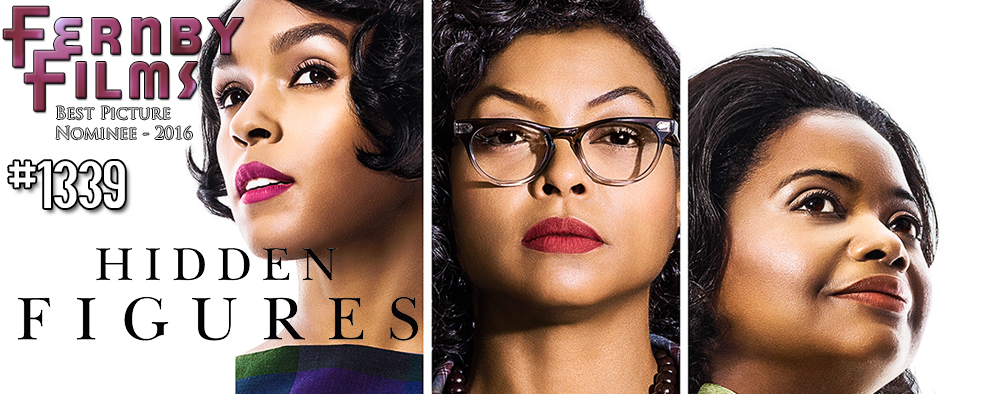
Director : Theodore Melfi
Year Of Release : 2016
Principal Cast : Taraji P Henson, Octavia Spencer, Janelle Monae, Kevin Costner, Kirsten Dunst, Jim Parsons, Glenn Powell, Mahershala Ali, Donna Briscoe, Rhoda Griffis, Maria Howell, Aldis Hodge, Paige Nicollette, Gary Weeks.
Approx Running Time : 127 Minutes
Synopsis: The story of a team of African-American women mathematicians who served a vital role in NASA during the early years of the US space program.
*********
The great space-race has spurred countless films about all the associated stories behind the scenes, films like October Sky, The Right Stuff, Australia’s own The Dish, Apollo 13 and others have shed light on both the practical – science and mathematical – and fantastical efforts to get humans into space, and inevitably onto the moon. Hidden Figures broadsides the political dismorphia of current cultural ructions to deliver a film about the empowerment of Negro women in the early 60’s United States, as three exceptionally intelligent women aide NASA in the achievement of space travel. Yes, it copes with entrenched racism, sexism and bias, wrapped in the knowing nostalgia of eventual success, and despite hitting a few off-key beats, Hidden Figures is compelling, amusing, excellent film-making that makes as little noise as possible despite feeling like it’s doing just the opposite.
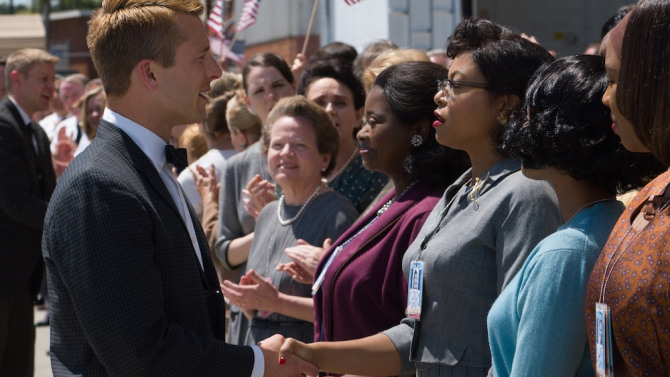
Three incredibly intelligent mathematics and engineer graduates, Katherine Goble (Taraji P Henson), Dorothy Vaughn (Octavia Spencer) and Mary Jackson (Janelle Monae) work at NASA as human “computers” dedicated to analysing numbers to aide in the great race to launch a man into space. With Russia successful launching a satellite – Sputnik – and eventually a man, Cosmonaut Yuri Gagarin into orbit, NASA Task Group director Al Harrison (Kevin Costner) becomes increasingly frustrated by the largely insufficient speed at which his team (including Paul Stafford, played by Jim Parsons) is working. With the arrival of complex supercomputers known as I.B.M.’s soon to threaten the women’s jobs, the race is on to get America into space and beyond and forever stamp their names into history.
Hidden Figures (otherwise known to various people as Hidden Fences, thanks to Michael Keaton – LOL) tells a beautiful, often painful story, and tells it well. Director Theodore Melfi (St Vincent) draws substantial emotive connection from Margot Shetterly’s book depicting the three women at the core of this story, with is soft-toned racism and sense of social propriety given a distinctly warm, glowing style reminiscent of Forrest Gump’s patriotic aesthetic. The glass-ceiling to be shattered here, however, isn’t so much the outer atmosphere of planet Earth (although that is a key element to the plot), but rather the indifference, scorn and occasionally outright disdain the scientific community of America had for black people – women, especially – of the time.
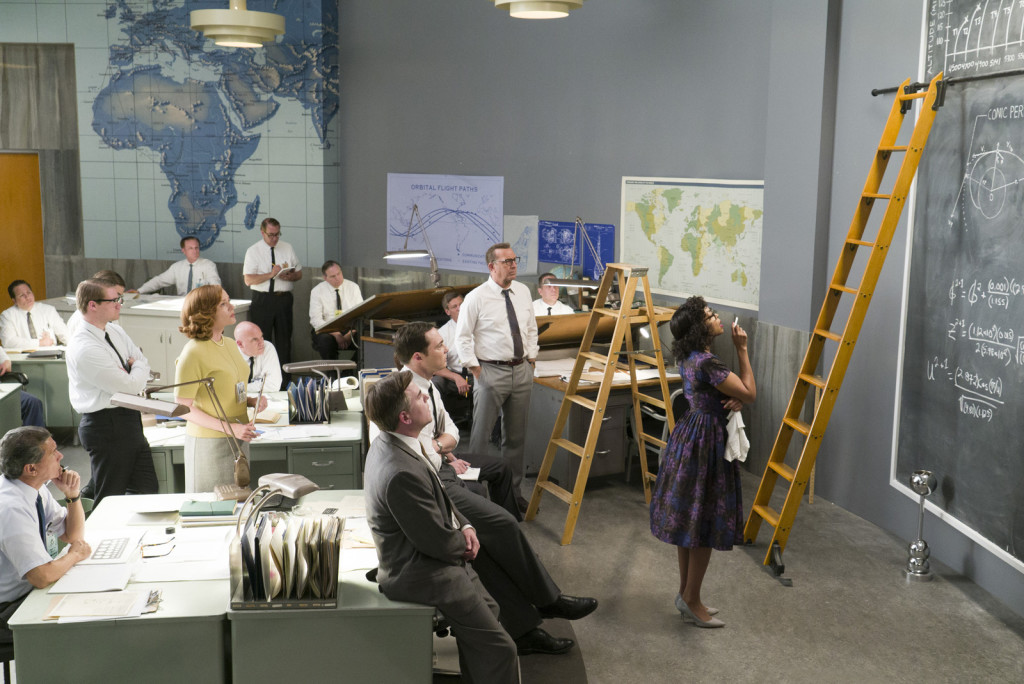 Jim Parsons’ role of Paul Stafford is the very coagulation of American prejudice in a single character, passive-agressively putting down Henson’s Katherine Goble whenever she tries to step up with her intellect. It’s not a cruel role, mind, but a reflection on the anachronistic racism endemic throughout the country, particularly Virginia and the Deep South, at the time. The story doesn’t dwell too significantly on the three women’s backstory other than a brief prologue about how they were sent to a better school once their gifts were realised; the bulk of the film covers three linked but separate arcs.
Jim Parsons’ role of Paul Stafford is the very coagulation of American prejudice in a single character, passive-agressively putting down Henson’s Katherine Goble whenever she tries to step up with her intellect. It’s not a cruel role, mind, but a reflection on the anachronistic racism endemic throughout the country, particularly Virginia and the Deep South, at the time. The story doesn’t dwell too significantly on the three women’s backstory other than a brief prologue about how they were sent to a better school once their gifts were realised; the bulk of the film covers three linked but separate arcs.
The prime storyline deals with Goble’s work within the Space Task Force at NASA itself, alongside the “brightest and the best” intellectual minds America had to offer. Goble’s work as a human computer (this was just as the first supercomputers were coming into being) allowed calculations to be made relatively quickly, providing astrophysicists, engineers and military personell with information to make a rocket fly into space, and safely deliver an astronaut back to Earth. Taraji Henson’s work as Goble is moving, easily the strongest element of the film, and her work with both Kevin Costner and Jim Parsons is appreciably strong. Octavia Spencer plays Dorothy Vaughn, a woman serving as an unofficial supervisor for NASA’s pool of black “computers”, who wants to move up within the organisation and find a purpose for herself before the choice is removed from her. Spencer’s role is smaller than I’d have liked, but the actress delivers requisite composition and strength in the face of racial adversity.
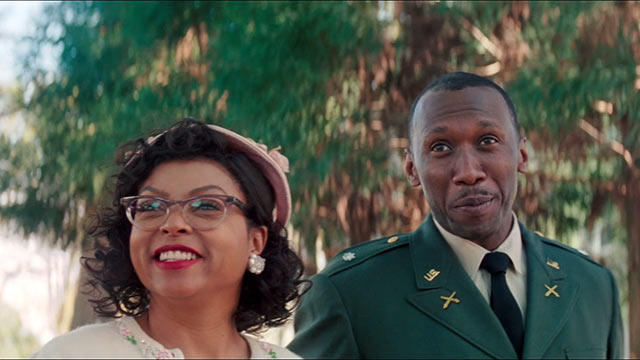 Lastly, Janelle Monae’s work as Mary Jackson, who decides to take up further study at a segregated public school in order to further her prospects within NASA, has a minor romantic interlude with Mahershala Ali (Marvel’s Luke Cage, Moonlight) that has little to do with the spacey stuff but works reasonably well as contrast to the more prescient arcs within the film. Kevin Costner’s Al Harrison is typically stoic Costner at his most Costerniest, giving the character resolute patriotism and a moral forthrightness that overcomes much of the racial element within the subtext. Harrison’s acceptance of Goble as an intellectual equal to the others on his team, and his admiration for her work ethic and stubbornness, is easily within Costner’s square-jawed acting range, and he delivers it perfectly; it must be said, however, that a couple of his monologues, no doubt intended to rally the troops, feel a little too on-the-nose to resonate well, despite their earnestness. Parsons’ work is nice enough, as is Mahershala Ali’s, while minor roles to Kirsten Dunst and Glenn Powell (as real life John Glenn) provide context to the characters’ respective journeys.
Lastly, Janelle Monae’s work as Mary Jackson, who decides to take up further study at a segregated public school in order to further her prospects within NASA, has a minor romantic interlude with Mahershala Ali (Marvel’s Luke Cage, Moonlight) that has little to do with the spacey stuff but works reasonably well as contrast to the more prescient arcs within the film. Kevin Costner’s Al Harrison is typically stoic Costner at his most Costerniest, giving the character resolute patriotism and a moral forthrightness that overcomes much of the racial element within the subtext. Harrison’s acceptance of Goble as an intellectual equal to the others on his team, and his admiration for her work ethic and stubbornness, is easily within Costner’s square-jawed acting range, and he delivers it perfectly; it must be said, however, that a couple of his monologues, no doubt intended to rally the troops, feel a little too on-the-nose to resonate well, despite their earnestness. Parsons’ work is nice enough, as is Mahershala Ali’s, while minor roles to Kirsten Dunst and Glenn Powell (as real life John Glenn) provide context to the characters’ respective journeys.
Despite well intentioned storytelling and pitch-perfect performances from all, not to mention dead-on period detail down to the computers, costumes and associated tech within NASA at the time, Melfi’s direction feels too good-natured for the undercurrent of racial tension within the film. It’s as if there’s a vague notion of good-old-boy aww-shucks to the film, cliche and sentimentality rampant throughout the film’s more obvious finale (we know, for example whether John Glenn actually survives his trip into space), and mawkish romanticism of the period threatens to undo much of the terrific early work here. Whereas the film prides itself on its “black women overcoming entrenched racial prejudice” motif, threaded throughout much of the film’s early going, the almost heroic, often anthemic catch-cry of feminism threatens to send the film’s more straightforward narrative stumbling over the finish line.
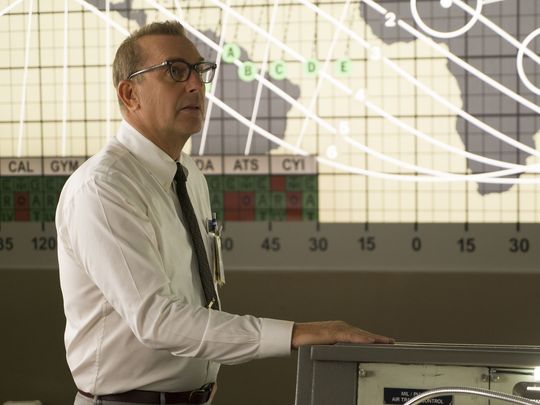 Rousing, well mounted stories don’t come with much better pedigree than Hidden Figures. There are too few films telling these kinds of stories, and I’m pleased that this film turned out so well. It’s a testament to both the film production and the people it’s all based on, both historically and socially relevant now perhaps even moreso than it was at the time. Hidden Figures avoids direct narrative on America’s racial problems, using them as a platform to personify the sheer goodness of the three women at the center of the film, while casually emasculating many of the men within it (detrimentally, I might add). It’s a tricky thing to pull off, this kind of story, but Hidden Figures is an excellent example of real life being far stranger than fiction; this film is well worth a look.
Rousing, well mounted stories don’t come with much better pedigree than Hidden Figures. There are too few films telling these kinds of stories, and I’m pleased that this film turned out so well. It’s a testament to both the film production and the people it’s all based on, both historically and socially relevant now perhaps even moreso than it was at the time. Hidden Figures avoids direct narrative on America’s racial problems, using them as a platform to personify the sheer goodness of the three women at the center of the film, while casually emasculating many of the men within it (detrimentally, I might add). It’s a tricky thing to pull off, this kind of story, but Hidden Figures is an excellent example of real life being far stranger than fiction; this film is well worth a look.









 It’s not ‘Hidden Fences’: Jenna Bush Hager, Michael Keaton’s Golden Globes flub
It’s not ‘Hidden Fences’: Jenna Bush Hager, Michael Keaton’s Golden Globes flub